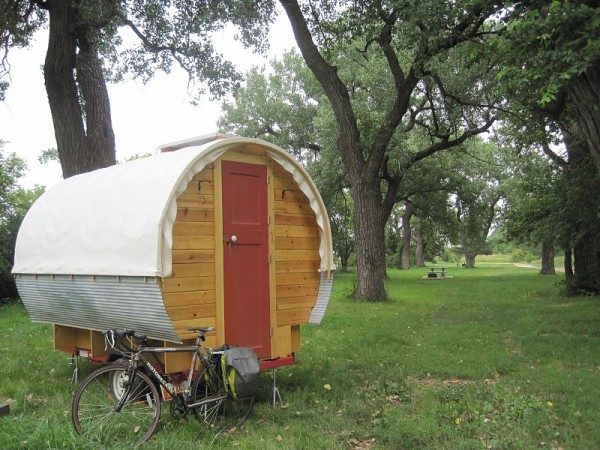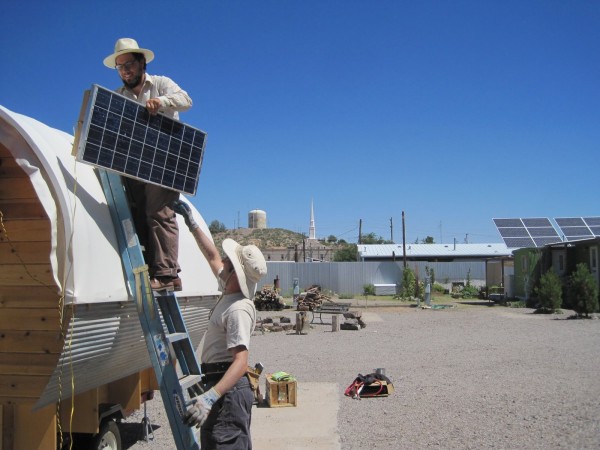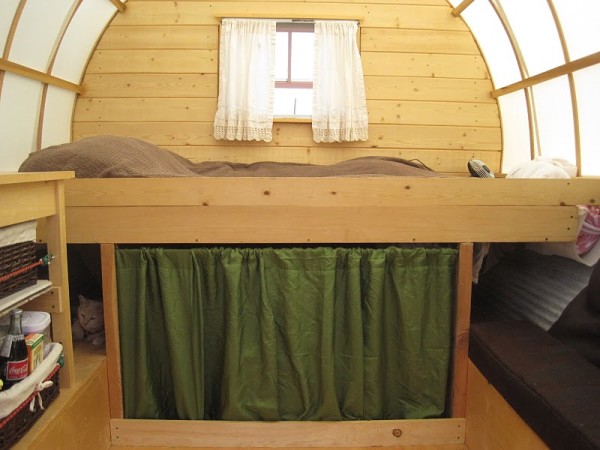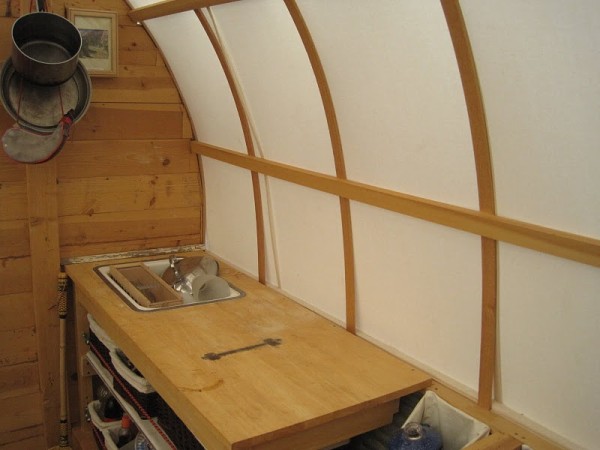Libby sent me an update on their Contemporary Prairie Schooner and I’ll let Libby tell you about it.
We began construction on our tiny home in March. Now, at the beginning of July, we are living full time in our prairie schooner while we travel cross country. I will be blogging our journey on www.whittleddown.com. Also be sure and read the Grand Tour on our blog that goes more into detail on some of the components of our home.

The schooner has solar electricity, passive solar hot water, a functioning sink, and a camp stove for meal prep. We are using a cooler to refrigerate our food and have a pantry for non-refrigerated items as well. We sleep on a homemade straw mattress and have a handmade couch for lounging. Our cat has an outdoor enclosure for birdwatching.


Our maximum travel speed is 55 mph, so we are taking the scenic route on this journey. We’ll be making our way through the midwest in a north-easterly direction, with Western Massachusetts being our final destination. Our little 4 cylinder Hyundai is handling the extra strain admirably.

The final construction cost of this project is somewhere between $1500 and $2000. We offset the cost by $1000 selling our possessions so that we could fit everything into our new home, making the net cost $500-$1000. We used salvaged materials whenever possible, and we relied heavily on borrowed tools from our local Tool Library.

The only power tool we actually owned was a drill gun with no reverse (our jigsaw broke about 1 month into construction). Because we were working on a deadline, we used more new materials than we would have had we had the luxury of time to scavenge.

Even so, as beginners we were able to build a functioning portable tiny home on a tight budget in 4 months. We’re considering drawing up detailed plans for this project, and we would love to hear from anyone out there who would be interested in such a thing.





Nice job on the trailer. It looks great. I am not sure how it would do in colder climates, but nice to see what people can do when they put their mind to it.
Congratulations – you’ve finished with aplomb! I live in Western MA myself and dream of a trailer like this as I need the light weight for my Honda Element to pull it. Have a great trip and welcome to our neighborhood. Maybe we’ll connect and I’d love to see plans!
As of right now, the two and their wagon are settled in our driveway. They are both amazing people and their wagon is even cooler in person. We wish them luck with the rest of their journey.
Love it! love the price tag! I would be interested in more info on how you built it, dimensions, performance, any thing you would change. Yes it is inspiring to those of us who have no construction experience.
I like the effect of the light coming through the canvas covering.
How do you feel about using a cookstove in a canvas covered wagon? Do you get smoke damage?
I’m guessing something like this is only meant for summer travelling. You’d have to live in a warm climate campground with toilet facilities for year-round living.
Looks awesome! Are there any issues/kinks in the structure? Would be great to hear about any issues that came up.
I love the idea that working and building and living in a budget …however , I don’t think I like the idea that using the limited water , space …and on …In a short camping trip is ok , in a long trip like that …I think I would whine all the way from here to there (I can’t stand bugs , can’t live far away from a real bathroom and prefer air conditioning if possible lol ) But I always admire people who live in the tight budget and they are a survivors …Salute those brave people . TM.
I like your creativity. You have some interesting ideas. If the bugs get blown in, what is your plan to keep the water out if you are driving in the rain?
Gary
Cozy!! Cozy and cool!
I would like to see some info on the solar panel you installed if you have it could you email it to me? Thanks in advance!
Russ
It’s an awesome little trailer. I love it. I enjoyed the cat space as I have a couple. It’s important that they have a place too! Is the litter behind the curtain?
I’ve been contemplating a yurt and started the process of building one, and would like a secondary structure on wheels to escape to and move around my land a little more easily. I may be interested in your plans and what kind of trailer you used. I’m also a novice builder and need simple, step-by-step instructions. I’m wondering how the canvas holds up at those speeds and whether it could be insulated for cold weather use.
Cheers!
I love the cat run, what a great idea. Nice design.
Very impressive! And the price makes it within the reach of many people. I have seen a lot of projects posted here that look great but have ridiculous price tags. You are to be commended.
Again- great!
How does it haul aerodynamically? Any in-travel ad-ons/screens in the works? I’d imagine it might bulldoze air on the highway, which could lead to eventual damage. GREAT and inspiring project though, and you have a place to park in MA (and we’d love to film and interview you in HD) if you make it up here.
-Derek
relaxshacks.com
Thanks! It is obviously, not the most aerodynamic of structures, but since the trailer tires aren’t rated to go above 55mph anyway, we don’t drive it fast enough to experience a huge amount of resistance. So far it is holding up great. We’ve made a couple modifications so far, including a fix for the bug problem and a modification to the tin “fins”. I’ll be trying to get up some detailed posts about those soon at http://www.whittleddown.com
Oh PS- Where in MA are you? Thought you were in VT! We’d love to come see you.
Absolutely awesome! The wagon is beautiful. Can’t wait to see more updates on your guys’ blog. Have fun you guys.
Alex
Lovely. Looks lightweight enough to hitch up a team of bicycles to tow it too, you think?
Cool adventure!
– Love the indoor light. If it were shaped like a covered wagon, you’d have more floor space.
– For ventilation, try an arched window and screen/glass door. A deep window sill would be handy.
– If the bed were slightly lower, you could use it as a couch and elimminate the extra seating.
– Store extra blankets in pillowcases on the bed.
– Use pull-out storage boxes on shelving under the bed – for wardrobe, dry goods, dishes, pans.
– Use a cooler or camping porta-potti as an extra seat.
– To save counter space, do dishes in a basin on top of the counter. Store the basin when it’s not in use.
– Then create a shelf just large enough for the cook stove. Try one-pot recipes.
– Add coat hooks to the back of the door.
To remove things from under the bed, it may easier to use a set of curtains – with an opening in the middle – rather than one curtain.
Hi, Libby,
How’s life in a tiny home treating you? Jay Shafer came through Boulder and I got to meet him. I might be doing a radio assignment about him as well.
PS – Amory’s visiting home and reminded me that YOU have a tiny home . . . your prairie schooner. I espeically like the cat perch. Your cat looks like our Andy cat!
— Shelley
What a fun name – a prairie schooner!
I’d need the luxury of shower & loo though to feel ‘complete. Shape is appealing.So many of us are interested in your plans and dimensions that you’d better keep in touch with us all. Nice touch re the cattie.Happy days! Christine F. Andalucia , Spain.
Nice Trailer. That Coleman stove looks romantic but it’s a heavy, space consuming relic. We have tried everything and found the best, by far to be a Korean (or Japanese or Chinese) Butane stove. They have from an 8 to 12 square inch square footprint, depending on which model you choose. The butane refill bottles are half the size of baby propane bottles and the heat temp produced is as good as or better than a home gas range (much hotter than propane– and safe). We own a brownstone in Brooklyn and we decided to rent all the floors except the basement, which has a nice farm sink but no stove. So we moved in and used the 2 Korean burners while we were deciding which stove to buy– it’s been 3 years and we still use 2 of these as our stove with many a gourmet meal cooked and about half the NYC gas price of our 3rd floor gas range! Hope this helps someone looking for a viable everyday cooking tiny solution.